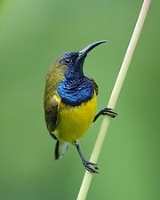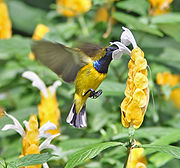
Olive-backed Sunbird
Encyclopedia
The Olive-backed Sunbird, Cinnyris jugularis, also known as the Yellow-bellied Sunbird, is a species of sunbird
found from Southern Asia to Australia
.
The sunbirds are a group of very small Old World
passerine
bird
s which feed largely on nectar, although they will also take insects, especially when feeding young. Their flight is fast and direct on their short wings. Most species can take nectar by hovering, but usually perch to feed most of the time.
 The Olive-backed Sunbird is common across southern China
The Olive-backed Sunbird is common across southern China
to the Philippines
and Malaysia down to northeast Australia
. They are small songbirds, at most 12cm long. In most subspecies
, the underparts of both male and female are bright yellow, the backs are a dull brown colour. The forehead, throat and upper breast of the adult male is a dark, metallic blue-black. In the Philippines (where they are known as "tamsi") the males of some subspecies have an orange band on the chest, in Wallacea
and northern New Guinea
some subspecies have most of the underparts blackish, and in southern China and adjacent parts of Vietnam
most of the underparts of the male are greyish-white.
Originally from mangrove
habitat, the Olive-backed sunbird has adapted well to humans, and is now common even in fairly densely populated areas, even forming their nests in human dwellings.
The birds mate between the months of April and August. Both the male and the female assist in building the nest which is flask-shaped, with an overhanging porch at the entrance, and a trail of hanging material at the bottom end.
After building the nest, the birds abandon the nest for about a week before the female returns to lay one or two greenish-blue eggs. The eggs take a further week to hatch. The female may leave the nest for short periods during the day during incubation. After the chicks have hatched, both male and female assist in the care of the young, which leave the nest about two or three weeks later.
Sunbird
The sunbirds and spiderhunters are a family, Nectariniidae, of very small passerine birds. There are 132 species in 15 genera. The family is distributed throughout Africa, southern Asia and just reaches northern Australia. Most sunbirds feed largely on nectar, but also take insects and spiders,...
found from Southern Asia to Australia
Australia
Australia , officially the Commonwealth of Australia, is a country in the Southern Hemisphere comprising the mainland of the Australian continent, the island of Tasmania, and numerous smaller islands in the Indian and Pacific Oceans. It is the world's sixth-largest country by total area...
.
The sunbirds are a group of very small Old World
Old World
The Old World consists of those parts of the world known to classical antiquity and the European Middle Ages. It is used in the context of, and contrast with, the "New World" ....
passerine
Passerine
A passerine is a bird of the order Passeriformes, which includes more than half of all bird species. Sometimes known as perching birds or, less accurately, as songbirds, the passerines form one of the most diverse terrestrial vertebrate orders: with over 5,000 identified species, it has roughly...
bird
Bird
Birds are feathered, winged, bipedal, endothermic , egg-laying, vertebrate animals. Around 10,000 living species and 188 families makes them the most speciose class of tetrapod vertebrates. They inhabit ecosystems across the globe, from the Arctic to the Antarctic. Extant birds range in size from...
s which feed largely on nectar, although they will also take insects, especially when feeding young. Their flight is fast and direct on their short wings. Most species can take nectar by hovering, but usually perch to feed most of the time.

China
Chinese civilization may refer to:* China for more general discussion of the country.* Chinese culture* Greater China, the transnational community of ethnic Chinese.* History of China* Sinosphere, the area historically affected by Chinese culture...
to the Philippines
Philippines
The Philippines , officially known as the Republic of the Philippines , is a country in Southeast Asia in the western Pacific Ocean. To its north across the Luzon Strait lies Taiwan. West across the South China Sea sits Vietnam...
and Malaysia down to northeast Australia
Australia
Australia , officially the Commonwealth of Australia, is a country in the Southern Hemisphere comprising the mainland of the Australian continent, the island of Tasmania, and numerous smaller islands in the Indian and Pacific Oceans. It is the world's sixth-largest country by total area...
. They are small songbirds, at most 12cm long. In most subspecies
Subspecies
Subspecies in biological classification, is either a taxonomic rank subordinate to species, ora taxonomic unit in that rank . A subspecies cannot be recognized in isolation: a species will either be recognized as having no subspecies at all or two or more, never just one...
, the underparts of both male and female are bright yellow, the backs are a dull brown colour. The forehead, throat and upper breast of the adult male is a dark, metallic blue-black. In the Philippines (where they are known as "tamsi") the males of some subspecies have an orange band on the chest, in Wallacea
Wallacea
Wallacea is a biogeographical designation for a group of Indonesian islands separated by deep water straits from the Asian and Australian continental shelves. Wallacea includes Sulawesi, the largest island in the group, as well as Lombok, Sumbawa, Flores, Sumba, Timor, Halmahera, Buru, Seram, and...
and northern New Guinea
New Guinea
New Guinea is the world's second largest island, after Greenland, covering a land area of 786,000 km2. Located in the southwest Pacific Ocean, it lies geographically to the east of the Malay Archipelago, with which it is sometimes included as part of a greater Indo-Australian Archipelago...
some subspecies have most of the underparts blackish, and in southern China and adjacent parts of Vietnam
Vietnam
Vietnam – sometimes spelled Viet Nam , officially the Socialist Republic of Vietnam – is the easternmost country on the Indochina Peninsula in Southeast Asia. It is bordered by China to the north, Laos to the northwest, Cambodia to the southwest, and the South China Sea –...
most of the underparts of the male are greyish-white.
Originally from mangrove
Mangrove
Mangroves are various kinds of trees up to medium height and shrubs that grow in saline coastal sediment habitats in the tropics and subtropics – mainly between latitudes N and S...
habitat, the Olive-backed sunbird has adapted well to humans, and is now common even in fairly densely populated areas, even forming their nests in human dwellings.
The birds mate between the months of April and August. Both the male and the female assist in building the nest which is flask-shaped, with an overhanging porch at the entrance, and a trail of hanging material at the bottom end.
After building the nest, the birds abandon the nest for about a week before the female returns to lay one or two greenish-blue eggs. The eggs take a further week to hatch. The female may leave the nest for short periods during the day during incubation. After the chicks have hatched, both male and female assist in the care of the young, which leave the nest about two or three weeks later.
External links
- Olive-backed Sunbird videos, photos & sounds on the Internet Bird Collection.
- BirdLife Species Factsheet

